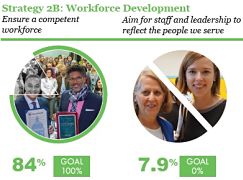Overview
The Harris County Public Health Department, Texas, created a department-wide health equity infrastructure, establishing overarching health equity policies, procedures, and staff training to infuse an equity lens into all divisions and programs.
Who Took This On
Harris County Public Health, TX
Ways You Can Get Started
- Train executive staff in health equity principles early on to build buy-in from leadership
- Support staff who want to make their programs more equitable while developing broader departmental policies
- Use department-wide training to support health equity champions throughout the agency
See Advice for Local Health Departments below for more ways to take action.
What Sparked This?
New Executive Director catalyzes agency to work further upstream
In 2013, Harris County Public Health (HCPH) hired a new Executive Director, who was promoted internally from within the department. He had previously served on NACCHO’s Health Equity Coalition for Local Health Departments. His work with NACCHO and connections to national health equity work meant that he brought to his new position knowledge of what other local health departments were doing around equity and a rationale for why HCPH needed to move beyond the status quo. His leadership catalyzed a shift within the agency to move their work further upstream.
Healthy equity made core element of 2013–2018 Strategic Plan
The same year their new Executive Director started, HCPH released a 5-year strategic plan, their first to use the language of equity rather than disparities. HCPH convened a 30-person committee to guide the plan development in 2012, and brought in Dr. Anthony Iton from the California Endowment to present on health equity. The committee also screened clips of Unnatural Causes in order to spark discussion about equity. The 2013–2018 Strategic Plan named equity as a core value, and identified addressing “public health issues in a manner that optimizes population health and achieves health equity” as 1 of 5 strategic directions.
Staff assessments and executive training pave the way for comprehensive health equity policy
In early 2014, HCPH used a modified version of the Bay Area Regional Health Inequities Initiative (BARHII) Organizational Self-Assessment Toolkit to assess staff willingness to embrace new concepts and health equity priority areas. In the same year, all top executive-level staff — about 10 people — completed NACCHO’s Health Equity and Social Justice self-study course in order to build buy-in among leadership. These executive staff then approved the launch of the department’s first peer-based learning collaborative on health equity using NACCHO’s Roots of Health Inequity course on the connections between social justice and public health.
HCPH creates a locally funded Health Equity Coordinator staff position
After a senior-level staff person left for another opportunity, HCPH decided to redirect a senior-level position in the Office of Planning and Policy to explicitly focus on health equity. The Senior Policy Planner/Health Equity Coordinator position was filled in 2014, and is locally funded, an important factor for the long-term sustainability of the work.
Academic partners provide key evidence base for health equity work
HCPH had relationships with academics at Rice University and the University of Texas School of Public Health. These partners were able to complement the Department’s own epidemiology data and needs assessment work by providing analysis on county demographics, health outcomes, and social determinants of health, including primary survey data collection. These data sets and relationships with academic partners provided a key evidence base for HCPH’s health equity work.
Program Description
Creating a health equity framework that shows how health inequities occur and how to break the cycle
In 2014, the Health Equity Coordinator came on board and developed clear annual goals for her own work and for the agency’s broader transformation. The first year’s goals included many foundational elements, such as creating a health equity framework and policy, developing staff training and a resource library, and building relationships with external experts, for example from academic institutions and the state health department.
Using the BARHII framework, the Health Equity Coordinator developed a Harris County–specific Health Equity Framework, which serves as the department’s theoretical model for how health inequities occur and how to break that cycle. It was completed in 2015 with input from a cross-sectional staff project team formed to work on health equity. The framework is a loop rather than a linear chain, recognizing that “disproportionate downstream morbidities can essentially ‘restart’ root causes of health inequities by further disadvantaging populations from social and economic resources” (Shah, Hadayia, and Forys, 2016). The framework notes key public health actions that can break this cycle.
Developing a health equity infrastructure with an internal advisory committee
With the framework in place, the Health Equity Coordinator and the staff project team began to develop the first elements of the department’s health equity infrastructure. The infrastructure consists of 3 elements:
- Health Equity Policy: Outlines high-level expectations
- Health Equity Procedures: Step-by-step instructions and a checklist
- Health Equity Workplans: Planned health equity “retrofits” for each division, office, and major program so they apply a health equity lens to day-to-day public health practice
In 2016, the Department developed a Health Equity Advisory Charter, which formally established the mission of the new Health Equity Advisory Committee; its purpose and authority, roles and responsibilities, composition, and values; and expectations of participants. Since its creation in the summer of 2016, the 10-member Health Equity Advisory Committee has met monthly and plays a key role in guiding the Health Equity Coordinator on priorities, acting as subject matter experts, and advising on staff training. The Health Equity Coordinator is now in the process of working with each division to create the workplans that will infuse health equity into the day-to-day practice of each office and program.
Cultivating health equity champions through training
In order to build workforce capacity, HCPH created a staff health equity training “journey series” consisting of Health Equity 101, 201, and 301 courses. Beginning in 2016, all department staff are required to take Health Equity 101, a 50-minute training that can be done in person or online that breaks down the Health Equity Framework and introduces foundational concepts.
Health Equity 201 is a learning collaborative in which participants move through a 10-week session (4 meetings in person and 6 online) as a cohort.
- 15 to 25 people per cohort are selected by division directors and/or self-selected because of personal interest.
- NACCHO’s Roots of Health Inequity web-based course is used as a basis for the 201 training, but is adapted for HCPH’s needs.
- After graduating from the 201 course, each participant writes up a health equity story about what health equity means to them and how they plan to advance equity through their work. These stories are then distributed to the entire staff through a department-wide newsletter and are used in the Health Equity 101 training.
Health Equity 301 is a more personalized course on how to be a health equity champion.
- Participants have a personal commitment to health equity, and work closely with the Health Equity Coordinator to develop specific health equity goals for their divisions, and plans for carrying them out.
- The goal is to soon have 30 staff — and eventually more — who have completed the 301 course and can act as champions throughout the department.
Monitoring internal and external progress and outcomes
The Health Equity Coordinator tracks goals and outcomes annually. In the early years many of these have been process outcomes related to internal trainings and infrastructure. Setting clear goals and reporting on progress has been key to keeping the work’s momentum going. HCPH also created a public-facing Health Equity Dashboard with health equity goals for specific sections of the Strategic Plan. These include programmatic efforts like addressing blight, cultivating a workforce that represents the demographics of the county, and increasing the collection and analysis of client data by race, ethnicity, and language.
Outcomes and Impacts
-
92% of department staff completed Health Equity 101 training in 2016
Over 500 staff members, contractors, and interns went through the initial course, with an 80% pass rate for the knowledge quiz. In addition, more than 50 staff completed the Health Equity 201 Learning Collaborative, and 9 staff completed the 301 course to become Health Equity Champions.
-
Health equity is being operationalized in unexpected places
Divisions and projects that didn’t seem like obvious places for advancing health equity have taken on this work. For example, the Department’s Veterinary Public Health Division is working to ensure that spay-neuter-release programs do not only release stray cats into low-income neighborhoods. Another example is that HCPH has reoriented their client grievance process into a “Client Bill of Rights.” Using HCPH’s Health Equity Procedures, staff worked to adopt plain language and a rights-based framework to empower clients rather than merely focusing on how they can register a complaint. These are just some examples of the many large and small retrofits of current programs using a health equity lens.
-
NACCHO names HCPH as “Local Health Department of the Year”
In 2016 NACCHO awarded HCPH Large Local Health Department of the Year due to their equity work. This recognition, along with their other achievements, has helped position HCPH as a go-to regional organization for health equity.
HCPH used their health equity policy and procedures to redesign their response to the Zika virus, as described in an article in Health Equity:
“We used sub-county social and economic indicators such as social vulnerability, poverty, and illegal dumping as criteria for mosquito abatement strategies. . . . [W]e developed a Zika communications plan that prioritizes populations experiencing historical inequities such as the homeless and those living in economically disinvested neighborhoods. Repellent and other prevention modalities are distributed to these vulnerable groups.”
Future Steps
- HCPH will continue staff training, including revising Health Equity 101 materials based on feedback from the first round of implementation. In addition to this all-staff training, HCPH aims to have 30 Health Equity Champions who have completed the 301 training and more in the pipeline.
- Using its health equity infrastructure, HCPH is also ready to ramp up their community- and place-based work to tackle geographic health inequities.
- The Health Equity Coordinator also plans to bring external stakeholders into HCPH’s Health Equity Advisory Committee in order to build accountability with community and outside experts.
Advice for Local Health Departments
-
Build executive-level knowledge and capacity early on
Having all Division executives go through NACCHO’s Health Equity and Social Justice course as well as participate in the first cohort of the Department’s health equity learning collaborative created early buy-in and paved the way for universal training of staff.
-
Let policy and program updates inform each other
Building internal infrastructure and policies takes a long time. The Health Equity Coordinator notes that while she initially imagined this would be a linear process from narrative change to programmatic change, she’s learned that these can also happen simultaneously and, as a result, inform each other in an iterative manner. She states that theory and practice are both critical to agency transformation. She recommends trying early on to get concrete examples from enthusiastic staff about how they build health equity into their work, and then identify specific tools or supports that can help staff do more and better health equity work right away.
-
Use training and internal advisory committees to seed health equity experts through the department, and not just among “the usual suspects”
As the Health Equity Coordinator stated, “The more times that I’m not the one at the table saying equity, the better! That means that our vision is getting diffuse throughout the Department. . . . From the beginning, I wasn’t shocked that some staff, such as community health workers or epis, embraced equity, but I was pleasantly surprised that staff from very diverse disciplines, like veterinarians, entomologists, or even finance, embraced it so much. It was great for them to be all in.” Ensuring that equity leadership teams contain a “slice” of the entire organization means a department can build leadership in unexpected places.










